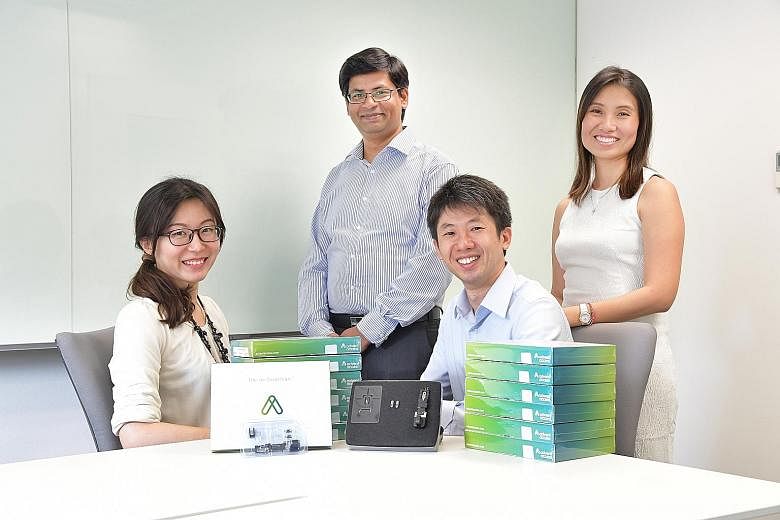Q When Advent Access was founded in 2015, what plans did you have?
A Advent Access first started within the Agency for Science, Technology and Research (A*Star) as a grant-funded project. I was the principal investigator of the project, researching and developing our first product known as the av-Guardian.
It's a device placed under the skin, "a pioneer concept" of having a "guide door" to the special dialysis vein called the AV fistula.
An AV fistula is a specially surgically modified vein that a patient needs to use to draw blood in order to commence haemodialysis. It is also known as the lifeline of kidney failure patients, and there are a limited number of places where you can create this vein.
When we spun off in 2015, we licensed all the intellectual property and patents from A*Star exclusively to the start-up. I was running the Singapore-Stanford Biodesign programme, which I still do as a part- time programme director.
We felt the time was right to spin off the company and take the technology to the market via a start-up.
Q Why did you decide to work on the project in the first place?
A I've always been a tinkering person, while working in Silicon Valley and as a Stanford Biodesign Fellow - a year-long programme by Stanford University - and it hasn't changed.
The technologies the world needs are those that find clever ways to take cost out of the system.
I found kidney failure disease intriguing as medical advancement turned it from a terminal illness into a chronic disease, allowing the patient to have as close to a normal life as possible. But it's created a dilemma, crippling healthcare systems. It's a space where there's room for innovation. The renal area is a huge market, a US$90 billion (S$128 billion) market worldwide.
I started thinking of the renal and kidney failure areas as early as 2010 or 2011. I wanted to go where the needs are more pressing.
What made me want to further invent things was that over the last few years, as I got to know more dialysis patients, I saw a growing wish among them to have a quality of life that's as close to that of a healthy individual as possible. I wanted to find out a better way for them to continue this therapy long term.
Only one out of five patients gets a transplant, and their whole lives revolve around the dialysis machine, but a lot of them do have the desire to work.
Q How does the av-Guardian work?
A As a "guide door", you're able to get to the vein more reliably, or get more reliable vascular access, instead of relying on blind needling, of being subject to the skill variability of nurses. For dialysis, the needles are big as they need to draw 40 litres of blood in four hours, and return that back to the body.
Next, it will allow patients to use blunt needles instead of sharp needles - which can lead to six, sometimes up to 18, new injuries each week, across different parts of the vein and skin.
It's because we're now able to guide the needle to enter an optimal place to access blood, in a consistent position, angle and depth. This reduces wear and tear on the vein, with the potential to reduce hospitalisation and surgery. Blunt needling can also be less painful, akin to putting on an ear ring.
With those two points, we can potentially enable patients to "self- needle", or let non-medical caregivers insert the needle, unlocking patients' ability to do independent dialysis; av-Guardian makes these patients "plug and play" ready for the future.
Q How is the av-Guardian disruptive to the market?
A One way is from the vascular point of view and another is disrupting the dialysis modality.
In the vascular area, we want to disrupt vascular care - to maintain the health of the AV fistula vein, preventing operator-related complications in the first place, delaying the need for repair work on the vein so fewer hospital visits are required. The technologies we're aware of now focus a lot on repairing.
For dialysis modality, we hope what we're doing represents a "vascular access 2.0" system that will "unlock" more people to have the ability to perform haemodialysis independently, or self-haemodialysis.
The market penetration for home haemodialysis technology is low, in the United States it's 1 to 3 per cent and the reason is that no one has figured out safe and easy home vascular access.
Vascular access for dialysis, which has been around for more than 70 years, is still the Achilles' heel of this therapy.
Vascular access 2.0 is the missing link, for haemodialysis 2.0 technologies to really take off.
Q In what other ways does Advent Access plan to disrupt the sector?
A The other thing we are looking into is whether you can do self-dialysis "in-centre". Smart dialysis centres of the future can have self-care stations, which could be used by patients with the av-Guardian.
A lot of doctors have said needling is the most difficult part of dialysis, so we're asking if we can start to disrupt the way in-centre dialysis is performed, so patients can have more control over the care they need and their time.
This could also reduce the cost of running a dialysis centre, where nursing labour costs make up the largest component of costs now.
It could also increase the capacity of dialysis centres, so machines that are idling can be utilised.
Q Where is Advent Access now with the av-Guardian?
A We aim to complete our clinical trials in four to six months, and we're in the midst of productisation. The next stage is regulatory approval.
We're heartened to know from preliminary records that the devices of patients who have completed the study fulfil safety and performance objectives well.
We also have some in-house research and development going on, on a complementary product or products. We're also still working with A*Star on advanced research.


